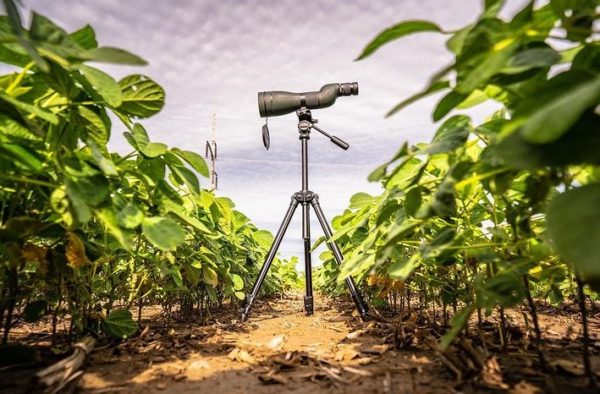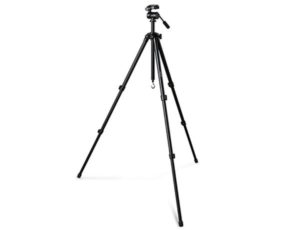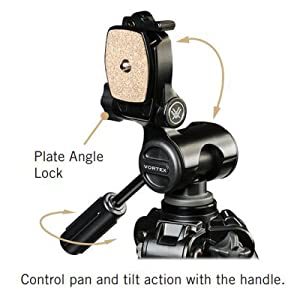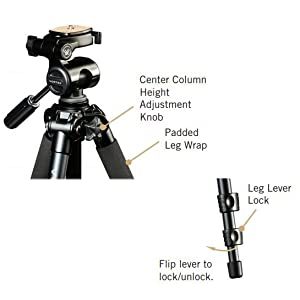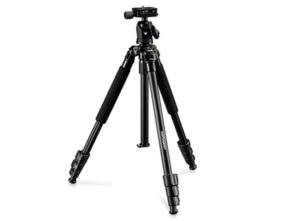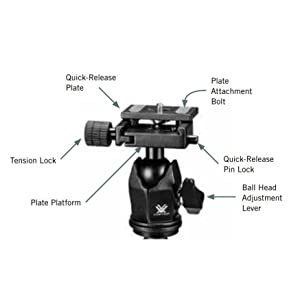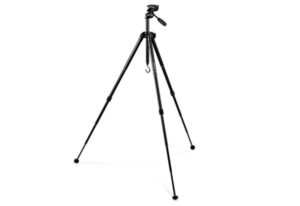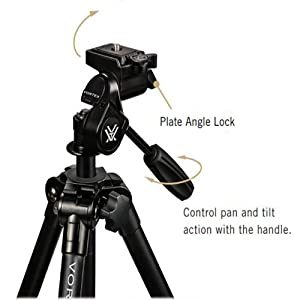Best Vortex Tripods Review.
A tripod is a three-legged stand that supports a camera, telescope, optics, or other objects that need to be kept steady.
A good tripod should be stable and sturdy enough for all your outdoor activities such as birdwatching, hunting, target shooting, or photography.
Vortex Optics has some of the best tripods on the market, let’s go through them.
Best Vortex Tripods
Vortex Optics Pro GT Tripod
|
Vortex Optics High Country Tripod
Check Best Price
As one of the best vortex tripods this Small, light, and compact tripod is designed for hunting at altitudes where every ounce counts. Set up is easy thanks to the variable leg angles and flip lever leg locks. The tripod extends to 52. 3 inches and folds down to 15 inches. The package includes a carry case, ball head, quick-release plate Features
Adjustments
Using the Quick-Release Plate
Adjusting the Tripod Legs
|
Vortex Optics Summit SS-P Tripod
Check Best Price
The Summit SS-P has a 3-way pan head that helps you to follow the action quickly and adjust your viewing angle easily while also letting you choose between horizontal and vertical plate alignments for camera use. You can use one hand to control all of the pans and tilt action. To make any horizontal or vertical adjustments, twist the handle counterclockwise to free the movement of the pan head. The tripod is compact and lightweight has a rugged build and is quick to assemble and operate. Features
Adjustments
Adjusting the Tripod Legs
|
Factors to Consider when Choosing the Best Vortex Tripods
Materials-Tripods are made of either aluminum or carbon fiber. Carbon fiber tripods are more lightweight but can compromise stability and sturdiness. They are also much more expensive. Aluminum tripods on the other hand have more durability hence last longer. They are also great at staying stable and grounded. However, they are too heavy to carry. It is best to avoid tripods that weigh less than 1.5 lb. /0.68 kg because they are simply too light and may end up wobbling too much.
Heads-The 2 common types of heads in tripods are ball head and pan head. Ball head tripods are great for photography but lack proper functionality for glassing. This is because you need precise and smooth movements for smooth glassing and panning. They are also much easier to use when scanning the landscape. Ball heads can create a movement that goes in all directions making it hard to control and stay on track. In addition, you can buy a tripod and the head separately but it would cost more money. Scopes with higher magnification and larger objectives need durable tripod heads that can be costly.
The location that the tripod will be used-Where you plan to take your tripod and the activities that you plan to do with it are important to consider. If you intend to move a lot with your tripod, a lightweight tripod is the best for you as it will be convenient.
Accessories-Tripods that come with a carrying bag and other additional accessories are usually great as you do not need to buy them separately.
Height-A tripod can be used from a prone, crouched, seated, or standing position. The maximum height of a tripod is essential especially if you are using a straight spotting scope. You want to ensure that you have a tripod with a comfortable maximum height so that you don’t end up crouching for several hours, which is not just uncomfortable but also bad for your back’s health.
Why Vortex Tripods
- Balance hook under the center column enhance stability under windy conditions and extreme weather
- Legs are not only durable but also easy to adjust
- Have a great maximum height
- Vortex offers an unconditional lifetime warranty that guarantees protection and replacement of your equipment
- Rubber feet ensure that the tripods are solid even on slick surfaces
FAQS about Best Vortex Tripods
- Can I use a camera tripod for a spotting scope?
Yes, you can. A camera tripod can be used for spotting scopes, but it will have its limitations. A camera tripod will not provide all the functions that a tripod for a spotting scope will. Use tripods meant specifically for spotting scopes so as to have a better experience. Nonetheless, spotting scopes tripods are usually more durable, portable, and sturdy
- How do I choose a tripod for a spotting scope?
When choosing a tripod for a spotting scope, always consider the weight, strength, and size of the tripod with the spotting scope’s weight and size. You should consider purchasing a tripod that can hold your spotting scope while keeping itself stable and sturdy if your spotting scope has a large size and weight.
- How is a tripod attached to a spotting scope?
A tripod can be attached to a spotting scope by just sliding your plate on the mounting platform of the tripod or by simply screwing it into place. Always remember to keep one hand on the spotting scope while adjusting the tripod legs and center column. The same procedure can be repeated when panning your scope.
- What are tripods made of?
Tripods are made of different materials. The cheapest ones are made of plastic which is not much recommended as it gets damaged easily and warps quickly, leaving the tripod unstable.
Better ones are made of aluminum which is good and offers a good combination of sturdiness and low weight. The most expensive tripods are made of carbon fiber which is obviously very expensive. It is lightweight and most durable as well. Magnesium can be sometimes be used in addition for the castings to reduce weight even more and at the same time increases cost.
- How should a tripod be cleaned and maintained?
Tripods should be kept dry at all times to prevent damage over time. That is why you should have a microfiber cloth with you to ensure that it is always dry and clean at all times. Water or other fluids are not recommended. When it comes to the storage of the tripod, you should put it into its bag and store it horizontally in a place that is dry and dark. Avoid locking the legs too firmly as it would damage the legs.
Conclusion
The Best Vortex Tripods are not only quality but also reliable and perform way better than your normal tripod. One of the above-reviewed tripods is best suited for your different tripod needs.
See Also: Best Vortex Spotting Scopes Review

